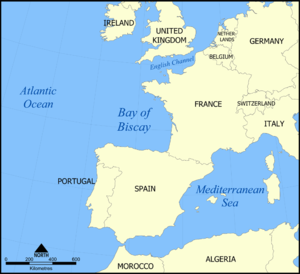
Operation Tonga was the codename given to the airborne operation undertaken by the British 6th Airborne Division between 5 June and 7 June 1944 as a part of Operation Overlord and the D-Day landings during the Second World War.

Operation Ladbroke was a glider landing by British airborne troops during the Second World War near Syracuse, Sicily, that began on 9 July 1943 as part of Operation Husky, the Allied invasion of Sicily. The first Allied mission using large numbers of the aircraft, the operation was carried out from Tunisia by glider infantry of the British 1st Airlanding Brigade, commanded by Brigadier Philip Hicks, with a force of 136 Hadrians and eight Airspeed Horsas. The objective was to establish a large invasion force on the ground near the town of Syracuse, secure the Ponte Grande Bridge and ultimately take control of the city itself with its strategically vital docks, as a prelude to the full-scale invasion of Sicily.

Operation Fustian was an airborne forces operation undertaken during the Allied invasion of Sicily in July 1943 in the Second World War. The operation was carried out by Brigadier Gerald Lathbury's 1st Parachute Brigade, part of the British 1st Airborne Division. Their objective was the Primosole Bridge across the Simeto River. The intention was for the brigade, with glider-borne forces in support, to land on both sides of the river. They would then capture the bridge and secure the surrounding area until relieved by the advance of British XIII Corps, which had landed on the south eastern coast three days previously. Because the bridge was the only crossing on the river and would give the British Eighth Army access to the Catania plain, its capture was expected to speed the advance and lead to the defeat of the Axis forces in Sicily.

The 1st Airborne Division was an airborne infantry division of the British Army during the Second World War. The division was formed in late 1941 during the Second World War, after the British Prime Minister, Winston Churchill, demanded an airborne force, and was initially under command of Major-General Frederick A. M. "Boy" Browning. The division was one of two airborne divisions raised by the British Army during the war, with the other being the 6th Airborne Division, created in May 1943, using former units of the 1st Airborne Division.

The Airspeed AS.51 Horsa was a British troop-carrying glider used during the Second World War. It was developed and manufactured by Airspeed Limited, alongside various subcontractors; the type was named after Horsa, the legendary 5th-century conqueror of southern Britain.

The Glider Pilot Regiment was a British airborne forces unit of the Second World War, which was responsible for crewing the British Army's military gliders and saw action in the European theatre in support of Allied airborne operations. Established during the war in 1942, the regiment was disbanded in 1957.
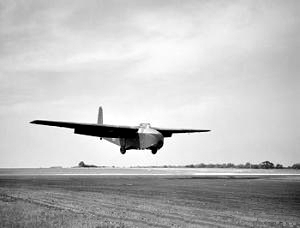
The General Aircraft Limited GAL.49 Hamilcar or Hamilcar Mark I was a large British military glider produced during the Second World War, which was designed to carry heavy cargo, such as the Tetrarch or M22 Locust light tank. When the British airborne establishment was formed in 1940 by the order of Prime Minister Winston Churchill it was decided to develop a large glider which would be able to transport heavy equipment in support of airborne troops. General Aircraft Limited were chosen in January 1941 to develop this glider, which they designated the GAL.49 'Hamilcar'. It was designed to transport a light tank or two Universal Carriers. A number of problems, which included vacillation by the War Office on the number of gliders it wanted and poor management by GAL, led to delays in the production of the Hamilcar and it was not until mid-1943 that the first production glider was assembled. These problems were only partially solved and production of the glider continued to be slow, hampered by difficulties in finding suitable locations to store and construct them once their parts were produced. A total of 344 Hamilcars had been built when production ended in 1946.

The General Aircraft GAL.48 Hotspur was a military glider designed and built by the British company General Aircraft Ltd during World War II. When the British airborne establishment was formed in 1940 by order of Prime Minister Winston Churchill, it was decided that gliders would be used to transport airborne troops into battle. General Aircraft Ltd were given a contract by the Ministry of Aircraft Production in June 1940 to design and produce an initial glider for use by the airborne establishment, which resulted in the Hotspur.

Glider infantry was a type of airborne infantry in which soldiers and their equipment were inserted into enemy-controlled territory via military glider. Initially developed in the late 1930s by Germany, glider infantry units were used extensively during World War II but are no longer used by any modern military.

Military gliders have been used by the militaries of various countries for carrying troops and heavy equipment to a combat zone, mainly during the Second World War. These engineless aircraft were towed into the air and most of the way to their target by military transport planes, e.g., C-47 Skytrain or Dakota, or bombers relegated to secondary activities, e.g., Short Stirling. Most military gliders do not soar, although there were attempts to build military sailplanes as well, such as the DFS 228.

The 1st Parachute Brigade, or the Red Devils, was an airborne forces brigade formed by the British Army during the Second World War. As its name indicates, the unit was the first parachute infantry brigade formation in the British Army.

The 1st Airlanding Brigade was an airborne infantry brigade of the British Army during the Second World War and the only glider infantry formation assigned to the 1st Airborne Division, serving alongside the 1st Parachute Brigade and 4th Parachute Brigade.
No 297 Squadron was a squadron of the Royal Air Force. It was notable for being the first airborne forces squadron formed. With sister No 296 Squadron it formed No 38 Wing RAF in January 1942, joined in August by No 295 Squadron; the Wing expanded in 1943 to become No 38 Group RAF. The squadron saw action in Sicily and took part in the D-Day invasion and Operation Market Garden. It was disbanded in 1950.
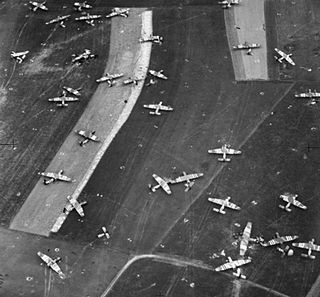
Operation Mallard was the codename for an airborne forces operation, which was conducted by the British Army on 6 June 1944, as part of the Normandy landings during the Second World War.
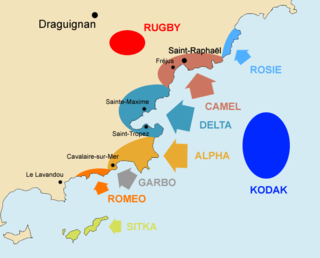
The British 2nd Parachute Brigade was part of the Operation Rugby airborne landings in August 1944. The operation was carried out by an ad hoc airborne formation called the 1st Airborne Task Force. Operation Rugby was itself part of the Operation Dragoon invasion of Southern France by the American 7th Army. The airborne task force landed in the River Argens valley with the objective of preventing German reinforcements from reaching the landing beaches. The landings were mainly an American operation and the brigade was the only British Army formation involved.

Paul Langdon Williams was a United States Army Air Forces and United States Air Force general. As head of the IX Troop Carrier Command during World War II, he was responsible for the airlift of the airborne landings in North Africa, Sicily, Italy, Normandy, southern France, the Netherlands and Germany.
No. 296 Squadron RAF was a transport squadron of the Royal Air Force during the Second World War. With sister squadrons 295 and 297 it formed 38 Wing, which later expanded to create No. 38 Group RAF.

The capture of the Caen canal and Orne river bridges was an operation by airborne forces of the British Army that took place in the early hours of 6 June 1944 as part of the Normandy landings of the Second World War. The objective was to capture intact two road bridges in Normandy across the River Orne and the Caen canal, providing the only exit eastwards for British forces from their landing on Sword Beach. Intelligence reports said both bridges were heavily defended by the Germans and wired for demolition. Once captured, the bridges had to be held against any counter-attack, until the assault force was relieved by commandos and other infantry advancing from the landing beach.
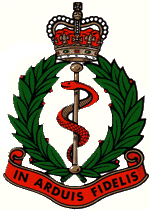
The 181st (Airlanding) Field Ambulance was a Royal Army Medical Corps unit of the British airborne forces during the Second World War.
The Airborne Forces Experimental Establishment (AFEE) was a branch of the British Air Ministry, that researched and developed non-traditional airborne applications, such as gliders, rotary wing aircraft, and dropping of personnel and equipment by parachute, in the period 1942–1950.
